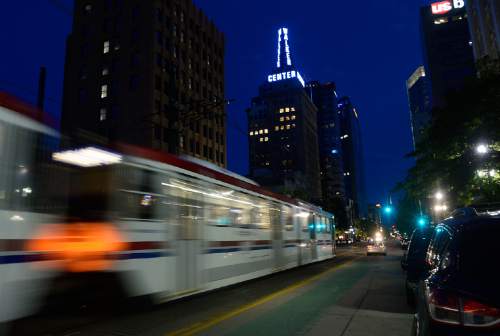This is an archived article that was published on sltrib.com in 2016, and information in the article may be outdated. It is provided only for personal research purposes and may not be reprinted.
The Utah Transit Authority achieved 61 percent of its 2015 goals, and that is good enough for 673 rank-and-file administration workers to split $647,000 in bonuses this year, averaging $961 each, the UTA Board decided Wednesday.
Top UTA executives — regional managers and higher — opted last year not to participate in bonus programs for two years amid controversy over past payments that ranged up to $30,000 each. They voluntarily waived bonuses before the vote on Proposition 1 last year on whether to raise sales taxes for transit and road improvements.
The bonus money approved will be split among rank-and-file administration workers — everyone from receptionists to accountants — essentially all workers not covered by union collective bargaining agreements. Drivers and mechanics generally are part of union agreements.
Every year, the UTA Board sets goals, and later awards bonuses to administrative employees based on results. Because 61 percent of goals were met, the board awarded 61 percent of the money set aside for bonuses.
One goal missed last year was to increase ridership by 3.3 percent. Instead, ridership remained essentially flat. UTA had 46.6 million boardings last year, down slightly by 23,000 rides from the previous year.
Acting CEO Jerry Benson earlier this month told a UTA committee that low gasoline prices enticed many people to use cars instead of transit.
"We know that when fuel [cost] declines as dramatically as it did last year, that we're typically going to see a decline in ridership," Benson said. "We're actually happy to be reporting that our ridership held steady."
He noted that transit ridership nationally dropped by 1.3 percent amid lower gas prices.
Because UTA missed the ridership goal, the board deducted 28 percent from the possible pool for bonuses.
UTA also missed a goal to have at least three groundbreakings for new "transit-oriented developments" near stations, and another goal to attract at least $75 million in federal grants.
Among goals that it did meet was holding the tax subsidy per ride — which UTA calls "investment per ride," or the cost of each ride not covered by fares — to $4.01 or less. UTA held it to $3.79 per ride, helped by lower fuel costs in 2015.
Another achieved goal was reaching a final decision on whether to proceed with a long-proposed "distance-based fare" system in which riders would pay for actual miles traveled instead of a flat fee for trips of any length.
UTA officials decided to scrap that idea after gathering feedback from customers.
Other goals the agency met included improving the way it measures performance and customer satisfaction. It also met goals for attracting some local money and grants.



